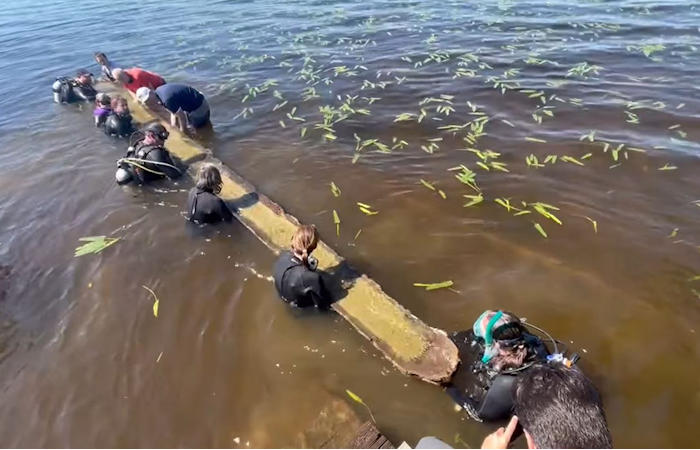Jan Bartek – AncientPages.com – An almost 1,000-year-old Native American canoe has been recovered from Lake Waccamaw in southeastern North Carolina, United States. The canoe was accidentally discovered by a group of teenage boys in 2021 while they were swimming in the lake. They first thought it was an ordinary log.
Authorities were notified, state officials later examined the boat, and the location of the Waccamaw Indian dug-out canoe was marked so the boat could later be safely removed.

1,000-year-old canoe pulled from North Carolina lake. Credit: North Carolina American Indian Heritage Commission
It’s rare to find pieces of history like this one, Waccamaw Siouan Chief Michael Jacobs said, commenting the discovery of the canoe.
“That canoe at 28 feet long would have carried many a brave. We feel like in our heart, it’s a history that we’re still exploring and understanding because this is the first time we’ve had access,” Jacobs told the ABC 15 News.
Eli Hill, one of the teenagers who found the boat was equally enthusiastic about the whole event.
“We were throwing mussels at each other and I stepped on it and I thought it was a log,” Hill said “I tried to pick it open and never came up. So, we kept digging at it and it just kept going. And then the next day, we came back and we started digging some more and it just kept going.”
Moving the Waccamaw canoe from the lake was a lengthy and delicate process, but certainly worth every effort. More than a dozen divers and volunteers were needed to pull the 28 feet long canoe from Lake Waccamaw.
“This canoe is about 1,000 years old, and it’s a southeastern Indian canoe, and it’s originated from this area,” Mintz told the . “So, we wanted the local Indian group to be part of it and share with the agency of it.
Native Americans have a long tradition of building canoes. canoe-making. The building techniques vary slightly depending on the tribe, but according to Wayne Valliere, whose native name is Mino-Giizhig this rich history and the cultural tradition of canoe building is critical to the future of the planet. Valliere teaches students at Northwestern University how to build Native birchbark canoes.
“It’s so important to bring awareness to our changing environment and to make sure those environments are still here for Northwestern graduates’ great grandchildren and generations beyond so that they will be able to breathe clean air and drink clean water. Without our environment, we have nothing,” Valliere says.
“We’re looking forward to examining it, running some tests on it, really finding out and going back to our elders and getting the history of it to where we can teach the truth to our people and know that we’ve got concrete evidence to stand on,” said Jacobs.
While Hill and his friends recognize the weight of their discovery, members of the Waccamaw Siouan Tribe are grateful.
“Our history is still unfolding,” said Jacobs. “When the colonists made contact with our tribe, there’s a lot of the things that we hailed as historical and meaningful to us that we’re still putting together.”
See also: More Archaeology News
It does not happen often, but sometimes Old Native American canoes have been found in lakes across the States. Last year, for example, a 3,000-year-old canoe was found in Wisconsin’s Lake Mendota. This incredible find turned out to be the oldest canoe found in the Great Lakes region. One can only wonder how many more ancient Native American boats are still in the waters waiting to be discovered and brought up on the land.
Written by Jan Bartek – AncientPages.com Staff Writer





